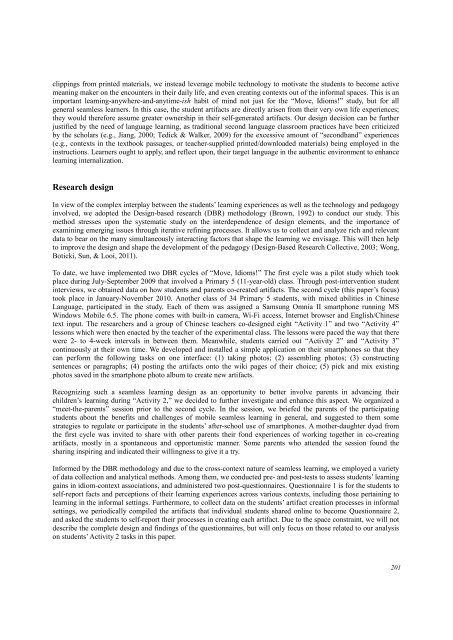Download Complete Issue in PDF - Educational Technology & Society
Download Complete Issue in PDF - Educational Technology & Society
Download Complete Issue in PDF - Educational Technology & Society
You also want an ePaper? Increase the reach of your titles
YUMPU automatically turns print PDFs into web optimized ePapers that Google loves.
clipp<strong>in</strong>gs from pr<strong>in</strong>ted materials, we <strong>in</strong>stead leverage mobile technology to motivate the students to become active<br />
mean<strong>in</strong>g maker on the encounters <strong>in</strong> their daily life, and even creat<strong>in</strong>g contexts out of the <strong>in</strong>formal spaces. This is an<br />
important learn<strong>in</strong>g-anywhere-and-anytime-ish habit of m<strong>in</strong>d not just for the “Move, Idioms!” study, but for all<br />
general seamless learners. In this case, the student artifacts are directly arisen from their very own life experiences;<br />
they would therefore assume greater ownership <strong>in</strong> their self-generated artifacts. Our design decision can be further<br />
justified by the need of language learn<strong>in</strong>g, as traditional second language classroom practices have been criticized<br />
by the scholars (e.g., Jiang, 2000; Tedick & Walker, 2009) for the excessive amount of “secondhand” experiences<br />
(e.g., contexts <strong>in</strong> the textbook passages, or teacher-supplied pr<strong>in</strong>ted/downloaded materials) be<strong>in</strong>g employed <strong>in</strong> the<br />
<strong>in</strong>structions. Learners ought to apply, and reflect upon, their target language <strong>in</strong> the authentic environment to enhance<br />
learn<strong>in</strong>g <strong>in</strong>ternalization.<br />
Research design<br />
In view of the complex <strong>in</strong>terplay between the students’ learn<strong>in</strong>g experiences as well as the technology and pedagogy<br />
<strong>in</strong>volved, we adopted the Design-based research (DBR) methodology (Brown, 1992) to conduct our study. This<br />
method stresses upon the systematic study on the <strong>in</strong>terdependence of design elements, and the importance of<br />
exam<strong>in</strong><strong>in</strong>g emerg<strong>in</strong>g issues through iterative ref<strong>in</strong><strong>in</strong>g processes. It allows us to collect and analyze rich and relevant<br />
data to bear on the many simultaneously <strong>in</strong>teract<strong>in</strong>g factors that shape the learn<strong>in</strong>g we envisage. This will then help<br />
to improve the design and shape the development of the pedagogy (Design-Based Research Collective, 2003; Wong,<br />
Boticki, Sun, & Looi, 2011).<br />
To date, we have implemented two DBR cycles of “Move, Idioms!” The first cycle was a pilot study which took<br />
place dur<strong>in</strong>g July-September 2009 that <strong>in</strong>volved a Primary 5 (11-year-old) class. Through post-<strong>in</strong>tervention student<br />
<strong>in</strong>terviews, we obta<strong>in</strong>ed data on how students and parents co-created artifacts. The second cycle (this paper’s focus)<br />
took place <strong>in</strong> January-November 2010. Another class of 34 Primary 5 students, with mixed abilities <strong>in</strong> Ch<strong>in</strong>ese<br />
Language, participated <strong>in</strong> the study. Each of them was assigned a Samsung Omnia II smartphone runn<strong>in</strong>g MS<br />
W<strong>in</strong>dows Mobile 6.5. The phone comes with built-<strong>in</strong> camera, Wi-Fi access, Internet browser and English/Ch<strong>in</strong>ese<br />
text <strong>in</strong>put. The researchers and a group of Ch<strong>in</strong>ese teachers co-designed eight “Activity 1” and two “Activity 4”<br />
lessons which were then enacted by the teacher of the experimental class. The lessons were paced the way that there<br />
were 2- to 4-week <strong>in</strong>tervals <strong>in</strong> between them. Meanwhile, students carried out “Activity 2” and “Activity 3”<br />
cont<strong>in</strong>uously at their own time. We developed and <strong>in</strong>stalled a simple application on their smartphones so that they<br />
can perform the follow<strong>in</strong>g tasks on one <strong>in</strong>terface: (1) tak<strong>in</strong>g photos; (2) assembl<strong>in</strong>g photos; (3) construct<strong>in</strong>g<br />
sentences or paragraphs; (4) post<strong>in</strong>g the artifacts onto the wiki pages of their choice; (5) pick and mix exist<strong>in</strong>g<br />
photos saved <strong>in</strong> the smartphone photo album to create new artifacts.<br />
Recogniz<strong>in</strong>g such a seamless learn<strong>in</strong>g design as an opportunity to better <strong>in</strong>volve parents <strong>in</strong> advanc<strong>in</strong>g their<br />
children’s learn<strong>in</strong>g dur<strong>in</strong>g “Activity 2,” we decided to further <strong>in</strong>vestigate and enhance this aspect. We organized a<br />
“meet-the-parents” session prior to the second cycle. In the session, we briefed the parents of the participat<strong>in</strong>g<br />
students about the benefits and challenges of mobile seamless learn<strong>in</strong>g <strong>in</strong> general, and suggested to them some<br />
strategies to regulate or participate <strong>in</strong> the students’ after-school use of smartphones. A mother-daughter dyad from<br />
the first cycle was <strong>in</strong>vited to share with other parents their fond experiences of work<strong>in</strong>g together <strong>in</strong> co-creat<strong>in</strong>g<br />
artifacts, mostly <strong>in</strong> a spontaneous and opportunistic manner. Some parents who attended the session found the<br />
shar<strong>in</strong>g <strong>in</strong>spir<strong>in</strong>g and <strong>in</strong>dicated their will<strong>in</strong>gness to give it a try.<br />
Informed by the DBR methodology and due to the cross-context nature of seamless learn<strong>in</strong>g, we employed a variety<br />
of data collection and analytical methods. Among them, we conducted pre- and post-tests to assess students’ learn<strong>in</strong>g<br />
ga<strong>in</strong>s <strong>in</strong> idiom-context associations, and adm<strong>in</strong>istered two post-questionnaires. Questionnaire 1 is for the students to<br />
self-report facts and perceptions of their learn<strong>in</strong>g experiences across various contexts, <strong>in</strong>clud<strong>in</strong>g those perta<strong>in</strong><strong>in</strong>g to<br />
learn<strong>in</strong>g <strong>in</strong> the <strong>in</strong>formal sett<strong>in</strong>gs. Furthermore, to collect data on the students’ artifact creation processes <strong>in</strong> <strong>in</strong>formal<br />
sett<strong>in</strong>gs, we periodically compiled the artifacts that <strong>in</strong>dividual students shared onl<strong>in</strong>e to become Questionnaire 2,<br />
and asked the students to self-report their processes <strong>in</strong> creat<strong>in</strong>g each artifact. Due to the space constra<strong>in</strong>t, we will not<br />
describe the complete design and f<strong>in</strong>d<strong>in</strong>gs of the questionnaires, but will only focus on those related to our analysis<br />
on students’ Activity 2 tasks <strong>in</strong> this paper.<br />
201

















